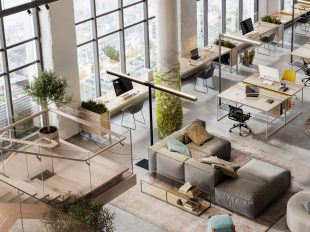More than two years have passed since the pandemic emergency broke out and we were forced to work remotely as a result. From that moment on, as is well known, the world of work has changed in a way that we would never have imagined up until that moment.
And, now that the darkest period of the pandemic appears to be a distant memory, companies are trying to figure out the best methodology for their future. The goal is obviously to promote productivity, an objective which, to be achieved, also takes into account the wellbeing of the employees.
The model that seems capable of ensuring the best results is that of hybrid work, consisting of a mix between working remotely and face-to-face.
How can the management of working spaces be tackled in a context such as this, in which the new challenges related to safety and performance evaluation are multiplying and where the very concept of work on site has changed its meaning, in favour of a greater enhancement of opportunities for interpersonal exchange?
The themes behind hybrid work
The new hybrid work model is based on a changed conception of work itself, considered in its complexity.
It is intertwined with the strong theme of safety (the ongoing pandemic generates a parameter that should not be underestimated), with the broader theme of sustainable mobility, with the parameters for evaluating the work of the human capital (from work “by hours” to work by objectives) and with a renewed quality attributed to the time spent on shared work activities.
The hybrid model promotes the presence of the worker in the office when, and if, really motivated by the need for meetings, exchanges and meetings with colleagues. Technology and innovation respond promptly and provide tools that can put the concept of hybrid work into practice to optimize the management of workspaces and take advantage of all the benefits of the new model of working activity.
The management of workspaces starts from the integration of software and hardware
In the age of hybrid work, the success of a company also depends on its ability to understand workflows and to better manage its spaces, always guaranteeing a productive, efficient, safe and comfortable work environment.
Everything revolves around the choice of dedicated software for the management and booking of spaces and workstations: the best ones are completely web based and also available from a mobile device, and so always accessible. But we can’t simply talk about a smartphone app. To be truly effective, the working space management system must feature a strong integration between software and hardware, thus allowing the booking and use of car parks, meeting rooms, workstations, gyms, seats in the canteen, workers’ personal lockers (smart lockers) and so on.
In this way, the staff becomes totally autonomous in planning their working hours on site, reducing costs and at the same time increasing the levels of security, privacy and productivity.
A system of this type enables the optimisation of the hours worked on site, mostly dedicated to meetings and discussions, by building offices and locations it is worth travelling to, to work individually or with colleagues, according to your needs. .
The functionalities of a software for booking company workspaces
In addition, we are not only talking about the workspace booking functions, or the check-in and check-out functions, in order to be able to effectively manage the availability of the various assets. In fact, the best software for the management of workspaces in the company also have dashboards for monitoring the performance and trends of use of the various company areas and the related services.
In this way the decision-making process can be made more effective, ensuring increasingly productive and comfortable workplaces. A fundamental aspect, especially in a period like this marked by the uncontrolled increase in voluntary resignations, which are on the rise especially where employees are dissatisfied with their company.




